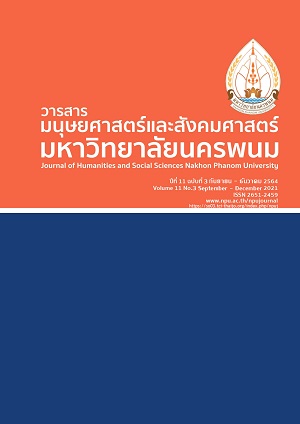การลดความสูญเปล่าในกระบวนการไหลเวียนสินค้าสำเร็จรูป ด้วยหลักการแบ่งประเภทสินค้าคงคลังแบบเอบีซีร่วมกับ ECRS กรณีศึกษาธุรกิจร้านค้าวัสดุก่อสร้าง
Main Article Content
Abstract
The purpose of research is to study about the loss reduction in finished goods flow process and illustrate the alternative of waste reduction of finished goods flow by ABC inventory classification principle with ECRS. A Quantitative method is used for this research and a research data is gathered by individual observation and in-depth interview from 16 interviewees. A building materials store business is specified to be the unit of analysis with IDEF analysis as well as the mentioned ABC inventory classification and ECRS. As a result of this study, found that the redundant inspection of splints and logs after the storage mostly cause the waste in the finished goods flow process. According to this issue, the researcher presents and applies the ABC inventory classification principle with ECRS and found that the time of flow process reduces for 28.30 minutes, 24.71 Bath of the flow cost process and 25 square meters lefts for storage area. The outcomes positively impact the increase of finished goods turnover rate at 4.54 times. Therefore, the researcher suggests construction materials shop and entrepreneur to concentrate the waste of flow process of finished goods, especially splint and logs which is the research contribution that will be beneficial for the storage control and management as sustainable efficiency.
Article Details
References
Kanjanapanyakorn, R. (2019). kānsưksā ngān ʻutsāhakam [Industrial Work Study] Bangkok: Printing Top
Shevasuthisilp, S. (2014, May – August). kānprayukchai theknik banchī tonthun kān lai wīan watsadu phư̄a lot khwām sūnsīa nai krabūan kō̜n phalit lamyai ʻop hǣng. [Application of Material Flow Cost Accounting Technique for Loss Reduction in the Process of Manufacturing Dried Longan. Nakhon Phanom University Journal. Vol 4 No.2; 7 – 4.
Almeida, A., & Cunha, J. (2017). The implementation of an Activity-Based Costing (ABC) system in a manufacturing company. Procedia manufacturing, 13, 932-939.
Bevilacqua, M., Ciarapica, F. E., & Mazzuto, G. (2016). Development of Scheduling Systems for a Shoe Factory Through IDEF0 and RFID Technologies. In Workshop on Business Models and ICT Technologies for the Fashion Supply Chain (pp. 179-186). Springer, Cham.
Chouhan,V., Soral, G., & Chandra, B. (2017). Activity based costing model for inventory valuation. Management Science Letters, 7(3), 135-144.
Dawood, L. M., & Abdullah, Z. H. (2019). WASTE MANAGEMENT OF AN INDUSTRIAL PRODUCT USING LEAN MANUFACTURING.
Dolgui, A., & Proth, J. M. (2010). Supply chain engineering: useful methods and techniques. Springer Science & Business Media.
Farooq, U. (2018). Impact of Inventory Turnover on Profitability of Non Financial Sector of Pakistan. J. Financ. Account. Res, 1(1).
Gupta, M., & Galloway, K. (2003). Activity-based costing/management and its implications for operations management. Technovation, 23(2), 131-138.
Kovačević, J. (2018). ABC ANALYSIS AS A TECHNIQUE OF INVENTORY CONTROL IN DISTRIBUTION COMPANIES. Engineering management, 4 (2), 78-86.
López-Soto, D., Angel-Bello, F., Yacout, S., & Alvarez, A. (2017). A multi-start algorithm to design a multi-class classifier for a multi-criteria ABC inventory classification problem. Expert systems with Applications, 81, 12-21.
Lu, T. Y., Wang, S. L., Wu, M. F., & Cheng, F. T. (2017). Competitive Price Strategy with Activity- Based Costing–Case Study of Bicycle Part Company. Procedia CIRP, 63, 14-20.
Russell, R. S., & Taylor, B. W. (2014). Operations and supply chain management. Hoboken, NJ: John Wiley & Sons.
Sharma, S., Kumar, R., Bhadana, P., & Gupta, S. (2013). News event extraction using 5W1H approach & its analysis. International Journal of Scientific & Engineering Research, 4(5), 2064-2068.
Kasemset, C., Pinmanee, P., & Umarin, P. (2014). Application of ECRS and Simulation Techniques in Bottleneck Identification and Improvement: A Paper Package Factory. In Proceedings of the Asia Pacific Industrial Engineering & Management Systems Conference.
Khan, J. A., Deng, S., & Khan, M. H. A. (2016). An Empirical analysis of inventory turnover Performance within a Local Chinese supermarket. European Scientific Journal, 12(34), 145-157.
Khristolyubova, A. A., Konev, A. A., Shelupanov, A. A., & Solovev, M. L. (2019). Modeling threats to information security using IDEF0 methodology. In IOP Conference Series: Materials Science and Engineering (Vol. 597, No. 1, p. 012071). IOP Publishing.
Xin, L. (2018). Multi-project Management Model based on ECRS Method.


